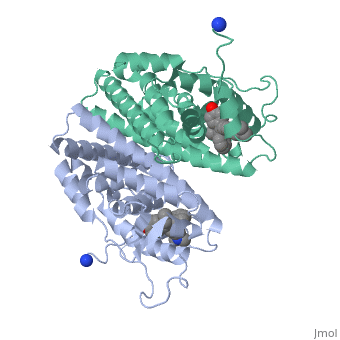Tamoxifen
From Proteopedia
(Difference between revisions)
| Line 6: | Line 6: | ||
== Tamoxifen and the Estrogen Receptor == | == Tamoxifen and the Estrogen Receptor == | ||
Tamoxifen lacks the second OH group as well as a tail containing oxygen and nitrogen on the ring.<ref name="danielle" /> Tamoxifen binds to the ligand binging domain of the estrogen receptor, which leads to a conformational shift.<ref name="danielle" /> The conformational change causes the <scene name='Sandbox_Reserved_385/12_helix_er/1'>helix 12</scene> to shift into an adjacent coactivator.<ref>Pecorak, Sara, and Tom Susman. "Tamoxifen, Diethylstilbesterol and the Estrogen Receptor Ligand Binding Region." (04). Web. <http://biology.kenyon.edu/BMB/Chime2/2001/estrogen/FRAMES/start.htm>.</ref> This site is essential for estrogen to do its job. Without the coactivator binding, the receptor remains inactive. Conformational changes also occur due to the new hydrophobic interactions between helices 3 and 11. These newly formed hydrophobic interactions lead to a cascade effect of conformational changes across the molecule. The new side chain also causes conformational changes since one of the rings in Tamoxifen is shoved deeper into the pocket. Tamoxifen also provides one less hydrogen bond in the pocket compared to estrogen, causing helices 3, 8, and 11 to extend. With the coactivator site blocked, there is a halt in proliferation, meaning that there is no cell growth. | Tamoxifen lacks the second OH group as well as a tail containing oxygen and nitrogen on the ring.<ref name="danielle" /> Tamoxifen binds to the ligand binging domain of the estrogen receptor, which leads to a conformational shift.<ref name="danielle" /> The conformational change causes the <scene name='Sandbox_Reserved_385/12_helix_er/1'>helix 12</scene> to shift into an adjacent coactivator.<ref>Pecorak, Sara, and Tom Susman. "Tamoxifen, Diethylstilbesterol and the Estrogen Receptor Ligand Binding Region." (04). Web. <http://biology.kenyon.edu/BMB/Chime2/2001/estrogen/FRAMES/start.htm>.</ref> This site is essential for estrogen to do its job. Without the coactivator binding, the receptor remains inactive. Conformational changes also occur due to the new hydrophobic interactions between helices 3 and 11. These newly formed hydrophobic interactions lead to a cascade effect of conformational changes across the molecule. The new side chain also causes conformational changes since one of the rings in Tamoxifen is shoved deeper into the pocket. Tamoxifen also provides one less hydrogen bond in the pocket compared to estrogen, causing helices 3, 8, and 11 to extend. With the coactivator site blocked, there is a halt in proliferation, meaning that there is no cell growth. | ||
| + | |||
| + | == Tamoxifen and the Estrogen-related receptor == | ||
| + | |||
| + | <scene name='50/501401/Cv/4'>Binding of nuclear receptor corepressor 2 peptide and 4-hydroxytamoxifen</scene> to human estrogen-related receptor γ. The chemotherapeutic drugs bisphenol and <scene name='50/501401/Cv/5'>tamoxifen</scene> are nestled between 4 alpha helices in the ERR active site <ref>PMID:16990259</ref>. | ||
== Tamoxifen, the Drug == | == Tamoxifen, the Drug == | ||
Current revision
| |||||||||||
- ↑ 1.0 1.1 1.2 Skafar, D., and S. Koide. "Understanding the Human Estrogen Receptor-alpha Using Targeted Mutagenesis." Molecular and Cellular Endocrinology 246.1-2 (2006): 83-90.
- ↑ Pecorak, Sara, and Tom Susman. "Tamoxifen, Diethylstilbesterol and the Estrogen Receptor Ligand Binding Region." (04). Web. <http://biology.kenyon.edu/BMB/Chime2/2001/estrogen/FRAMES/start.htm>.
- ↑ Wang L, Zuercher WJ, Consler TG, Lambert MH, Miller AB, Orband-Miller LA, McKee DD, Willson TM, Nolte RT. X-ray crystal structures of the estrogen-related receptor-gamma ligand binding domain in three functional states reveal the molecular basis of small molecule regulation. J Biol Chem. 2006 Dec 8;281(49):37773-81. Epub 2006 Sep 21. PMID:16990259 doi:http://dx.doi.org/10.1074/jbc.M608410200
Proteopedia Page Contributors and Editors (what is this?)
David Canner, Michal Harel, Andrea Danielle Merr, Joel L. Sussman, Alexander Berchansky


